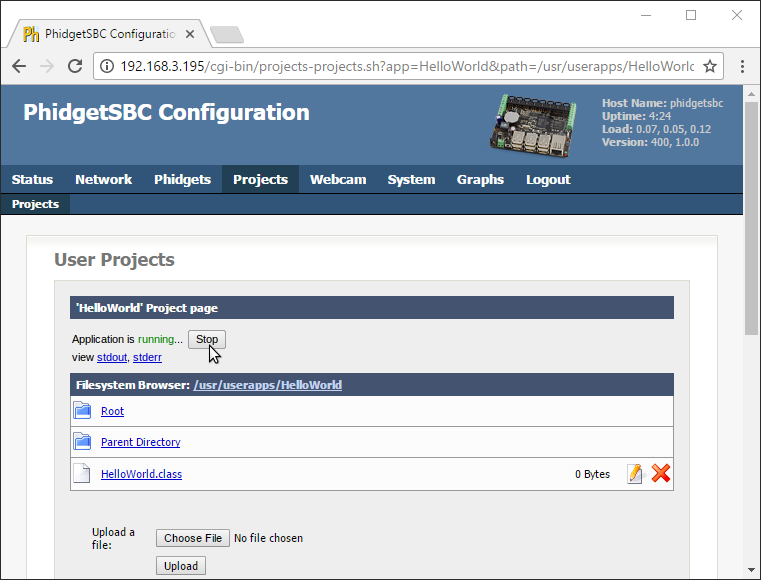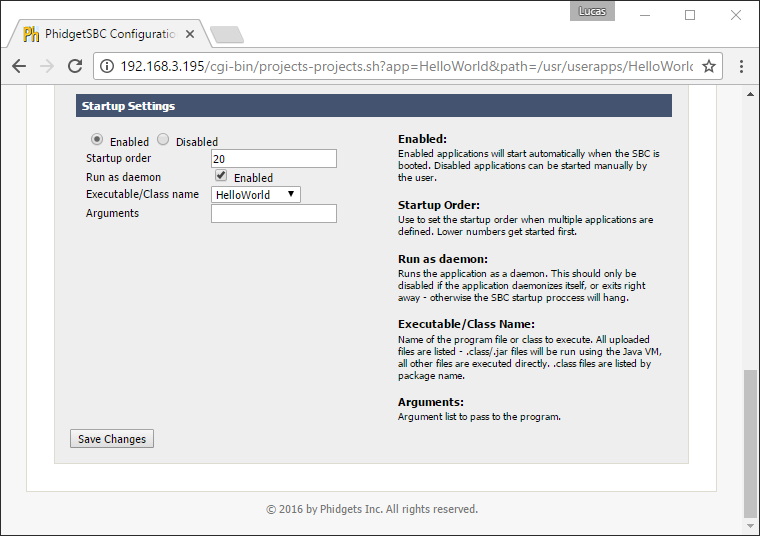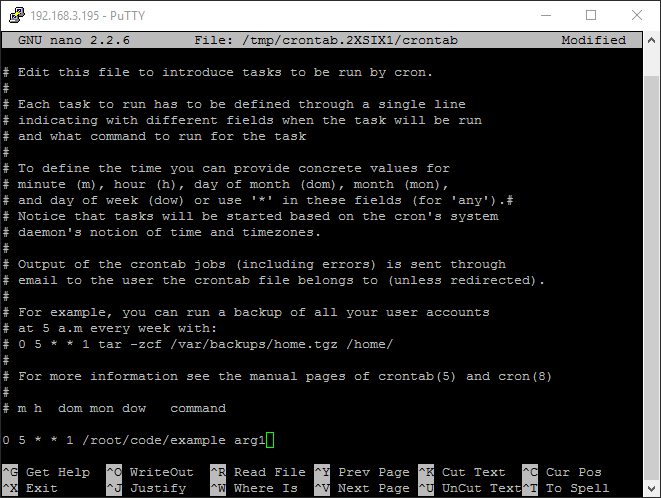|
|
| (566 intermediate revisions by 12 users not shown) |
| Line 1: |
Line 1: |
| __TOC__
| | __NOTOC__ |
| | [[Category:Language]] |
| | We provide support for the C language in all major operating systems. We also provide instructions on how to get your project started in a number of common development environments. Select your operating system and preferred development environment below, and follow the instructions to get your project running with Phidgets. |
|
| |
|
| ==Support==
| | If you do not know which development environment you want to use, or your development environment of choice is not listed, we recommend starting with GCC as the simplest path to getting your code running. |
|
| |
|
| C/C++ has a complete API and sample code for all Phidgets devices. For a complete list of the status for our [[Software Overview#Language Support | supported languages]], please [[Levels of Support|click here]].
| | Once you have set up your development environment to run with Phidgets, we recommend you follow our guide on [[Phidget Programming Basics]]. The guide will showcase the fundamentals of programming with Phidgets, with examples in C. |
|
| |
|
| If this is your first time working with a Phidget, we suggest starting with the ''Getting Started'' page for your [[Device List | specific device]]. That page will walk you through installing drivers and libraries for your operating system, and will then bring you back here to use C/C++ specifically.
| | == Setup Guide == |
|
| |
|
| C/C++ can be developed with various Windows compilers (including Borland), Mac OSX, and Linux.
| | <div class="phd-deck-sequence"> |
| | | {{PT3_C_CHOOSE}}{{PT3_C_WIN_VS}}{{PT3_C_WIN_VS_1}}{{PT3_C_WIN_VS_2}}{{PT3_C_WIN_CB}} |
| ==Quick Downloads==
| | {{PT3_C_WIN_GCC}}{{PT3_C_MAC_GCC}}{{PT3_C_LNX_GCC}}{{PT3_C_SBC_GCC}} |
| Before you can run your program, you need to set up the proper environment and get the necessary files off the Phidgets website.
| |
| Visit the drivers section at www.phidgets.com and get the latest:
| |
| * [http://www.phidgets.com/drivers.php Phidget Framework]
| |
| You will need the Phidget Framework to use and to program with Phidgets. We also recommend that you download the following reference materials:
| |
| * [http://www.phidgets.com/documentation/Phidget21_C_Doc.zip API Manual Download]
| |
| * [http://www.phidgets.com/documentation/web/cdoc/index.html API Manual Online]
| |
| * Example Code:
| |
| **[http://www.phidgets.com/downloads/examples/VCpp_2.1.8.20110615.zip Windows]
| |
| **[http://www.phidgets.com/downloads/examples/phidget21-c-examples_2.1.8.20110615.tar.gz Linux/MacOS]
| |
| * Phidget21 Library:
| |
| **[http://www.phidgets.com/downloads/libraries/phidget21-x86_2.1.8.20110615.zip 32 bit Windows]
| |
| **[http://www.phidgets.com/downloads/libraries/phidget21-x64_2.1.8.20110615.zip 64 bit Windows]
| |
| **[http://www.phidgets.com/downloads/libraries/phidget21bcc_2.1.8.20110615.zip Borland C++]
| |
| **[http://www.phidgets.com/downloads/libraries/libphidget_2.1.8.20111028.tar.gz Linux] ([[OS - Linux | Setup]])
| |
| **[http://www.phidgets.com/downloads/libraries/Phidget_2.1.8.20111103.dmg Mac OSX] ([[OS - Mac OSX | Setup]])
| |
| * You can find a high level discussion about programming with Phidgets in general on the [[General API]] page.
| |
| * The [[Device Functionality]] page explains the general operational information for your device.
| |
| | |
| You may want to have these pages open while working through these instructions.
| |
| | |
| ==Getting Started (Windows)==
| |
| | |
| The Phidget examples were written using Visual C++ 2005 and this tutorial assumes its use.
| |
| Other environments such as other versions of Visual Studio work as well and would be set up in a similar manner.
| |
| Borland C also requires the phidget21bcc.lib file provided at the Phidgets website.
| |
| Consult your compiler documentation for specific details on how to link to external libraries.
| |
| In Visual C++ 2005:
| |
| | |
| * Generate a new C/C++ console project with a descriptive name such as PhidgetTest.
| |
| * Copy phidget21.h and phidget21.lib from the VC/VC++/Borland examples and add them to your project directory.
| |
| * Open the project properties window.
| |
| * Navigate to Configuration Properties | Linker | Input.
| |
| * Edit the additional dependencies and add “phidget21.lib”.
| |
| | |
| The project now has access to the Phidget21 function calls and we are ready to begin coding.
| |
| | |
| ===Setting up the Libraries===
| |
| | |
| Before you can use the Phidget, you must include a reference to the library header.
| |
| | |
| <div style="background-color: #f3f3f3; border-color: #1c9edb; border-width:1px; border-style: dashed;"> | |
| <font size="3">
| |
| <source lang=cpp>
| |
| | |
| #include "phidget21.h"
| |
| | |
| </source>
| |
| </font>
| |
| </div> | | </div> |
|
| |
|
| Afterwards, the Phidget object will need to be declared and then initialized.
| |
| For example, we can declare a PhidgetInterfaceKit inside our main function with:
| |
|
| |
| <div style="background-color: #f3f3f3; border-color: #1c9edb; border-width:1px; border-style: dashed;">
| |
| <font size="3">
| |
| <source lang=cpp>
| |
|
| |
| int _tmain(int argc, _TCHAR* argv[])
| |
| {
| |
| CPhidgetInterfaceKitHandle ifKit = 0; //Declare an InterfaceKit handle
| |
| CPhidgetInterfaceKit_create(&ifKit); //Create the InterfaceKit object
| |
|
| |
| //More code goes here
| |
| return 0;
| |
| }
| |
|
| |
| </source>
| |
| </font>
| |
| </div>
| |
|
| |
| The object name for any type of Phidget is listed in the API manual.
| |
| Every type of Phidget also inherits functionality from the Phidget base class.
| |
|
| |
| You now have the libraries set up for either running the provided examples, or writing your own code, as below.
| |
|
| |
| ==Developing Code (Windows)==
| |
|
| |
| ===Running Examples===
| |
|
| |
| One good way to start developing your application is to run and modify existing examples. You can find the C/C++ API and example code here:
| |
|
| |
| *[http://www.phidgets.com/documentation/Phidget21_C_Doc.zip C/C++ API Reference]
| |
| *[http://www.phidgets.com/downloads/examples/VCpp_2.1.8.20111028.zip Microsoft Visual C/C++ Examples]
| |
| *[http://www.phidgets.com/downloads/examples/phidget21-c-examples_2.1.8.20111028.tar.gz Standard C/C++ Examples]
| |
|
| |
| To run the example code, you'll need to find the source code ''for your specific device'' within the example package. Then, compile the code under your platform and run it. This will allow you to:
| |
| * Make sure your libraries are properly linked, as above
| |
| * Go from source code to a test application as quickly as possible
| |
|
| |
| ===Writing Your Own Code===
| |
|
| |
| *[http://www.phidgets.com/documentation/Phidget21_C_Doc.zip C/C++ API Reference]
| |
|
| |
| You can use a Phidget in code by essentially by:
| |
| # Opening it,
| |
| # Setting it up,
| |
| # Doing things with it (like reading data), and
| |
| # Closing it.
| |
|
| |
| These steps are generally outlined for all devices and languages on the [[General Phidget Programming]] page. The [[General Phidget Programming]] page also introduces using the Phidget in an event-driven manner or in a traditional manner, both of which are available in C/C++.
| |
|
| |
| The ''complete'' set of functions you have available for all Phidgets can be found in the [http://www.phidgets.com/documentation/Phidget21_C_Doc.zip C/C++ API].
| |
|
| |
| If you are looking for more information about a particular function, we provide that as well. You can find more description on any function either in:
| |
| # Our [[General API|API Overview]] which describes the set of calls common to all Phidgets, or
| |
| # The [[Device List|Device API]] page for calls available only on your specific Phidget.
| |
|
| |
| ==Getting Started (MacOS/Linux)==
| |
|
| |
| ===Setting up the Libraries===
| |
|
| |
| Before you can use the Phidget, you must include a reference to the library header.
| |
|
| |
| <div style="background-color: #f3f3f3; border-color: #1c9edb; border-width:1px; border-style: dashed;">
| |
| <font size="3">
| |
| <source lang=cpp>
| |
|
| |
| #include <phidget21.h>
| |
|
| |
| </source>
| |
| </font>
| |
| </div>
| |
|
| |
| Afterwards, the Phidget object will need to be declared and then initialized. For example, we can declare a PhidgetInterfaceKit inside our main function with:
| |
|
| |
| <div style="background-color: #f3f3f3; border-color: #1c9edb; border-width:1px; border-style: dashed;">
| |
| <font size="3">
| |
| <source lang=cpp>
| |
|
| |
| int main(int argc, char* argv[])
| |
| {
| |
| CPhidgetInterfaceKitHandle ifKit = 0;
| |
| CPhidgetInterfaceKit_create(&ifKit);
| |
| //More code goes here
| |
| return 0;
| |
| }
| |
|
| |
| </source>
| |
| </font>
| |
| </div>
| |
|
| |
| The object name for any type of Phidget is listed in the API manual. Every type of Phidget also inherits functionality from the Phidget base class.
| |
|
| |
| ==Developing Code (Mac OSX/Linux)==
| |
|
| |
| ===Running Examples===
| |
|
| |
| One good way to start developing your application is to run and modify existing examples. You can find the C/C++ API and example code here:
| |
|
| |
| *[http://www.phidgets.com/documentation/Phidget21_C_Doc.zip C/C++ API Reference]
| |
| *[http://www.phidgets.com/downloads/examples/VCpp_2.1.8.20111028.zip Microsoft Visual C/C++ Examples]
| |
| *[http://www.phidgets.com/downloads/examples/phidget21-c-examples_2.1.8.20111028.tar.gz Standard C/C++ Examples]
| |
|
| |
| To run the example code, you'll need to find the source code ''for your specific device''. Then, compile the code under your platform and run it. This will allow you to:
| |
| * Make sure your libraries are properly linked, as above
| |
| * Go from source code to a test application as quickly as possible
| |
|
| |
| ===Writing Your Own Code===
| |
|
| |
| *[http://www.phidgets.com/documentation/Phidget21_C_Doc.zip C/C++ API Reference]
| |
|
| |
| You can use a Phidget in code by essentially by:
| |
| # Opening it,
| |
| # Setting it up,
| |
| # Doing things with it (like reading data), and
| |
| # Closing it.
| |
|
| |
| These steps are generally outlined for all devices and languages on the [[General Phidget Programming]] page. The [[General Phidget Programming]] page also introduces using the Phidget in an event-driven manner or in a traditional manner, both of which are available in C/C++.
| |
|
| |
| The ''complete'' set of functions you have available for all Phidgets can be found in the [http://www.phidgets.com/documentation/Phidget21_C_Doc.zip C/C++ API].
| |
|
| |
| If you are looking for more information about a particular function, we provide that as well. You can find more description on any function either in:
| |
| # Our [[General API|API Overview]] which describes the set of calls common to all Phidgets, or
| |
| # The [[Device List|Device API]] page for calls available only on your specific Phidget.
| |
|
| |
| ===Compiling Your Program===
| |
|
| |
|
| Compiling and linking against the Phidgets Library can be done in the following ways:
| | == Quick Downloads == |
|
| |
|
| *To build on Linux:
| | If you already know what you're doing and just need the files, you can find them all below. |
| :gcc example.c -o example -lphidget21
| |
| *To build on MacOS:
| |
| :gcc example.c -o example -framework Phidget21 -
| |
| :I/Library/Frameworks/Phidget21.framework/Headers
| |
|
| |
|
| ==Building your Project== | | === Documentation === |
|
| |
|
| Describe the different ways a project could be built and packaged using this language.
| | *{{Phidget22API}} (select C from the drop-down menu) |
|
| |
|
| ==Development Environments and Compilers== | | === Example Code === |
|
| |
|
| Describe each major compiler and notable differences or important information. (eg. framework versions) If there are known issues/workarounds mention them and link to the corresponding issue at the bottom of the page. <span style="color:red;">TO BE COMPLETED</span>
| | *{{SampleCode|C|C Examples}} |
|
| |
|
| ==Common Problems and Solutions/Workarounds== | | ===Libraries=== |
|
| |
|
| Here you can put various frequent problems and our recommended solutions.
| | {{AllQuickDownloads}} |




